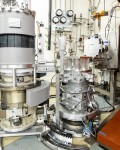Paige Kelley, a postdoctoral researcher with a joint appointment at the University of Tennessee and the Department of Energy’s (DOE’s) Oak Ridge National Laboratory (ORNL), is using neutrons to study specific crystal properties that could lead to the realization of a quantum spin liquid, a novel state of matter that may form the basis of future quantum computing technologies.
“In a quantum spin liquid, spins continually fluctuate due to quantum effects and never enter a static ordered arrangement, in contrast to conventional magnets,” Kelley said. “These states can host exotic quasiparticles that can be detected by inelastic neutron scattering.”
Recently, she and her team saw evidence of those quasiparticles in alpha-ruthenium trichloride, when they diluted the sample with a small amount of iridium. The iridium, Kelley says, suppresses the intrinsic long-range magnetic order in pure ruthenium trichloride making it possible to study the spin liquid state.
The team conducted low-temperature neutron diffraction measurements using the Four-Circle Diffractometer instrument, beamline HB-3A, and the Fixed-Incident-Energy Triple-Axis (FIE-TAX) Spectrometer, HB-1A, at ORNL’s High Flux Isotope Reactor (HFIR), a DOE Office of Science User Facility. They used both instruments to study the crystal structure, magnetic ground state, and magnetic moment sizes in single crystals of iridium-substituted ruthenium trichloride.
“I prepared single crystals in which a small amount of ruthenium was replaced by nonmagnetic iridium ions and used the Four Circle and FIE-TAX instruments to determine how this affected the magnetic order in the system,” Kelley said.
When a small amount of iridium is incorporated, she explained, they found that the onset of the magnetically ordered state occurs at a lower temperature than in pure ruthenium trichloride, and the low-temperature state shows a smaller ordered moment size. Both properties are indicators of the strength of the conventional magnetic interactions in the system.
“By adding nonmagnetic iridium we are weakening the long-range order that competes with the quantum spin liquid ground state in ruthenium chloride,” she said. “The suppression of the magnetic order is definitely a step in the right direction and opens up the possibility of realizing a quantum spin liquid in this material with sufficient iridium concentration.”
Neutron scattering has proven optimal for Kelley and her team’s research due to the way neutrons behave within magnetic materials.
“Because neutrons themselves have a spin, neutron scattering is much more sensitive to magnetic moments due to unpaired electrons in a sample than other techniques such as x-ray scattering,” Kelley said.
Before coming to ORNL, Kelley studied nanotechnology as a graduate research fellow at the University of South Florida. She continues to make new contributions in condensed matter physics and in the growing field of quantum materials.
“The quasiparticle excitations in a quantum spin liquid could be manipulated to construct quantum bits or qubits, the basic unit of quantum computation,” Kelley said. “This research could eventually lead to great strides in that field.”
HFIR is a DOE Office of Science User Facility. UT-Battelle manages ORNL for the DOE’s Office of Science. The Office of Science is the single largest supporter of basic research in the physical sciences in the United States, and is working to address some of the most pressing challenges of our time. For more information, please visit http://science.energy.gov/.






